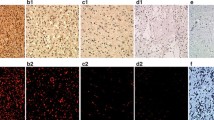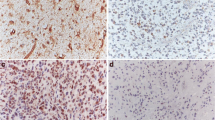Summary
Background
The negative consequences of the cytoplasmic localization of p16 in patients with high-grade astrocytomas, on their prognosis, was investigated.
Methods
p16 Expression was examined in 20 anaplastic astrocytoma and 42 glioblastoma patients by immunohistochemical analysis, and the relationship between both cytoplasmic and nuclear p16 expression and prognosis analyzed.
Results
The cytoplasmic expression of p16 statistically correlated with poor prognosis. On the other hand, no correlation was observed between p16 nuclear expression and patient survival.
Conclusion
The cytoplasmic immunoreactivity of p16 appears to be an unfavorable prognostic indicator in high-grade astrocytoma patients. The localization of p16 expression should be determined when evaluating the prognosis of these patients.
Similar content being viewed by others
Reference
Stewart LA, 2002 Chemotherapy in adult high-grade glioma: a systematic review and meta-analysis of individual patient data from 12 randomised trials Lancet 359(9311): 1011–1018
Gomez-Manzano C, Fueyo J, Kyritsis AP, et al. 1997 Characterization of p53 and p21 functional interactions in glioma cells en route to apoptosis J Natl Cancer Inst 89(14): 1036–1044
Costanzi-Strauss E, Strauss BE, Naviaux RK, et al. 1998 Restoration of growth arrest by p16INK4, p21WAF1, pRB, and p53 is dependent on the integrity of the endogenous cell-cycle control pathways in human glioblastoma cell lines Exp Cell Res 238(1): 51–62
Buschges R, Weber RG, Actor B, et al. 1999 Amplification and expression of cyclin D genes (CCND1, CCND2 and CCND3) in human malignant gliomas Brain Pathol 9(3): 435–442 discussion 432–433
Nobori T, Miura K, Wu DJ, et al. 1994 Deletions of the cyclin-dependent kinase-4 inhibitor gene in multiple human cancers Nature 368(6473): 753–756
Lukas J, Parry D, Aagaard L, et al. 1995 Retinoblastoma-protein-dependent cell-cycle inhibition by the tumour suppressor p16 Nature 375(6531): 503–506
He J, Allen JR, Collins VP, et al. 1994 CDK4 amplification is an alternative mechanism to p16 gene homozygous deletion in glioma cell lines Cancer Res 54: 5804–5807
Schmidt EE, Ichimura K, Reifenberger G, et al. 1994 CDKN2 (p16/MTS1) gene deletion or CDK4 amplification occurs in the majority of glioblastomas Cancer Res 54: 6321–6324
Ueki K, Ono Y, Henson JW, et al. 1996 CDKN2/p16 or RB alterations occur in the majority of glioblastomas and are inversely correlated Cancer Res 56: 150–153
Hama S, Sadatomo T, Yoshioka H, et al. 1997 Transformation of human glioma cell lines with the p16 gene inhibits cell proliferation Anticancer Res 17: 1933–1938
Hama S, Matsuura S, Tauchi H, et al. 2003 p16 Gene transfer increases cell killing with abnormal nucleation after ionising radiation in glioma cells Br J Cancer 89(9): 1802–1811
Sorenson CM, Barry MA, Eastman A, 1990; Analysis of events associated with cell cycle arrest at G2 phase and cell death induced by cisplatin J Natl Cancer Inst 82(9): 749–755
Nielsen GP, Stemmer-Rachamimov AO, Shaw J, et al. 1999; Immunohistochemical survey of p16INK4A expression in normal human adult and infant tissues Lab Invest 79(9): 1137–1143
Tam SW, Shay JW, Pagano M, 1994 Differential expression and cell cycle regulation of the cyclin-dependent kinase 4 inhibitor p16Ink4 Cancer Res 54(22): 5816–5820
Kamiryo T, Tada K, Shiraishi S, et al. 2002; Analysis of homozygous deletion of the p16 gene and correlation with survival in patients with glioblastoma multiforme J Neurosurg 96(5): 815–822
Evangelou K, Bramis J, Peros I, et al. 2004 Electron microscopy evidence that cytoplasmic localization of the p16(INK4A) “nuclear” cyclin-dependent kinase inhibitor (CKI) in tumor cells is specific and not an artifact. A study in non-small cell lung carcinomas Biotech Histochem 79(1): 5–10
Emig R, Magener A, Ehemann V, et al. 1998 Aberrant cytoplasmic expression of the p16 protein in breast cancer is associated with accelerated tumour proliferation Br J Cancer 78(12): 1661–1668
Milde-Langosch K, Bamberger AM, Rieck G, et al. 2001 Overexpression of the p16 cell cycle inhibitor in breast cancer is associated with a more malignant phenotype Breast Cancer Res Treat 67(1): 61–70
Ohgaki H, Dessen P, Jourde B, et al. 2004 Genetic pathways to glioblastoma: a population-based study Cancer Res 64(19): 6892–6899
Labuhn M, Jones G, Speel EJ, et al. 2001 Quantitative real-time PCR does not show selective targeting of p14(ARF) but concomitant inactivation of both p16(INK4A) and p14(ARF) in 105 human primary gliomas Oncogene 20(9): 1103–1109
Sano T, Oyama T, Kashiwabara K, et al. 1998 Immunohistochemical overexpression of p16 protein associated with intact retinoblastoma protein expression in cervical cancer and cervical intraepithelial neoplasia Pathol Int 48: 580–585
Chen Q, Luo G, Li B, et al. 1999 Expression of p16 and CDK4 in oral premalignant lesions and oral squamous cell carcinomas: a semi-quantitative immunohistochemical study J Oral Pathol Med 28: 158–164
Harada H, Nakagawa K, Iwata S, et al. 1999 Restoration of wild-type p16 down-regulates vascular endothelial growth factor expression and inhibits angiogenesis in human gliomas Cancer Res 59: 3783–3789
Fabbro M, Rodriguez JA, Baer R, et al. 2002 BARD1 induces BRCA1 intranuclear foci formation by increasing RING-dependent BRCA1 nuclear import and inhibiting BRCA1 nuclear export J Biol Chem 277(24): 21315–21324
Zhao P, Hu YC, Talbot IC, 2003 Expressing patterns of p16 and CDK4 correlated to prognosis in colorectal carcinoma World J Gastroenterol 9(10): 2202–2206
Acknowledgement
This study was supported in part by grants-in-aid from the Ministry of Education, Science and Culture, Japan.
Author information
Authors and Affiliations
Corresponding author
Rights and permissions
About this article
Cite this article
Arifin, M.T., Hama, S., Kajiwara, Y. et al. Cytoplasmic, but not nuclear, p16 expression may signal poor prognosis in high-grade astrocytomas. J Neurooncol 77, 273–277 (2006). https://doi.org/10.1007/s11060-005-9037-5
Received:
Accepted:
Published:
Issue Date:
DOI: https://doi.org/10.1007/s11060-005-9037-5




